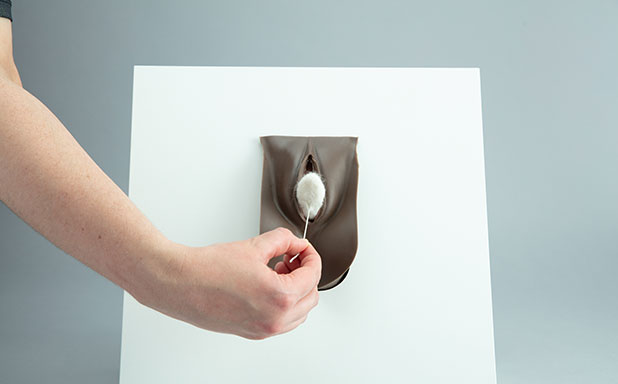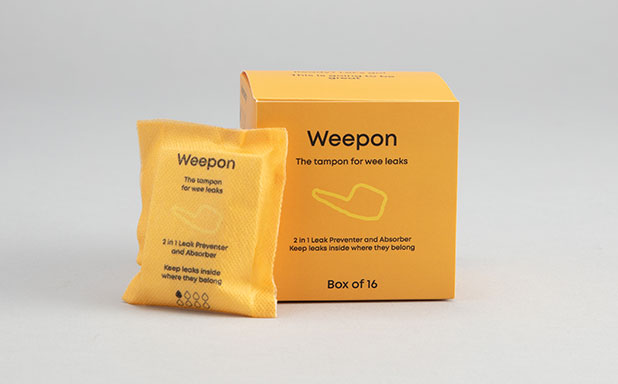Pads, pants and pessaries are what you can currently choose between if you experience involuntary urinary incontinence, and products like these have been available to women for the last 1,500 years. But if we started from scratch now, couldn’t we come up with something far better for those who experience urine leaks – and for the environment?
That was the mission of Jemma Queenborough, an Industrial Design and Technology student who’s just graduated this summer from Brunel University London. She’s researched and developed a stigma-busting product called Weepon which both absorbs and prevents urine leaks, and has a neat and discreet way of showing you it’s full and ready to be changed.
“Existing products for urinary incontinence have been around since about the 4th century, and they haven’t really changed that much,” Jemma said. “The user experience with them is awful and they don’t empower people.
“They’ve been updated to take advantage of modern liquid-absorbing materials, but the polymers used are made from a plastic base that isn’t biodegradable, so are bad for the environment.”
London-based Jemma, 33 and from West Wales, originally trained as a human rights lawyer, but switched her career to become a product designer. She’s keen to design with empathy, she explains, “to develop products that help in our most vulnerable moments, where design can really make a difference to how people feel and live their lives.”
So many people are affected. “A reported 69% of women, from young to old, leak urine – called urinary incontinence – and the stigma around this means it’s likely higher,” Jemma said. “But it’s not an inevitable part of ageing. Incontinence can be something people experience long term, only in certain situations, or temporarily, such as because of having had a baby or the effects of medication or surgery.
“Most people – 4 in 5 – don’t seek medical help at all to stop leaks, or wait up to 10 years, and treatment isn’t always available or successful.”
Stigma is a big cause of the delays. Jemma spoke to a sociologist, a psychologist, an anthropologist, a physiotherapist, a GP and a care provider to understand both the stigma on a human level and medical considerations, and to incorporate the considerations into her design. A key outcome of this was an idea for an internal product that both prevents and absorbs leaks, which doesn’t currently exist.

But Weepon isn’t a tampon. “The name, and calling it a ‘tampon for wee leaks’, tries to trigger mental associations with how you use it. It’s a completely new product people won’t recognise or have learnt how to use, so you’ve got to give people confidence to try it,” Jemma said – but tampons themselves aren’t a product for urine leaks. “Some people have tried to use a tampon to replicate a pessary, which puts pressure on your urethra from the inside. But tampons are not meant for that. There’s no menstrual blood, there’s no lubrication, it’s quite dry and doesn’t absorb anything.” Indeed, NICE, the National Institute for Health and Care Excellence, do not recommend using tampons this way.
Weepon is different in that it’s a two-in-one internal product designed specifically for urine leaks. There’s a vertical part – the Post – that acts like a pessary to stop leaks by putting pressure on the urethra, and a horizontal part that’s super-absorbent to catch any leaks that may get through as a back-up. And there’s a barrier between the two to make sure that urine doesn’t soak up into the vagina.
It’s made from compressed biodegradable fibre and biodegradable super-absorbent material that can safely hold up to 15 millilitres of urine, which the closest competitor labels as moderate to heavy urine leaks. Wrapped around all of this is a silky-feeling biodegradable material that reduces the potential for rubbing while you’re wearing it. The Post is structurally strengthened with a central core that gives a little more rigidity so it’s easier to insert, and it’s easy to remove by pulling the tampon-like string.
The cleverest part of the design is the wetness indicator, which can be read with just a simple touch, rather than relying on visual checking.
In comes in three different sizes and different Post lengths, depending on an individual’s needs and preference, and it can be worn just for an activity or for the day. For those whose incontinence is stress-related, such as due to the exertion of a gym session, Weepon can be put in just before and taken out just after. Or for those who experience urge incontinence – when you suddenly need to go and can’t hold it – it can be worn all day so it’s ready when you need it.
There’s also a reusable Post option, made from bioplastic and which can be lubricated, for those who want to insert and remove the Weepon multiple times over the course of a day. And a version to wear while you’re menstruating – because, as Jemma added, “urine leaks don’t stop for periods”.
Weepon is something people can use in the long term if necessary, Jemma explained, but the idea is that you use it for the shortest amount of time that you need it. “The aim is not to replace pelvic floor training and healthcare options to treat urine leaks if that’s an option for an individual. But when you are using it, it’s more discreet, sustainable and empowering than competitor products.”
Jemma showcased Weepon as part of Made in Brunel, the end-of-year showcase for Brunel Design School’s talented designers, held at the Bargehouse, Oxo Tower Wharf, London. With the right funding and backing, she’d like to further develop the product, secure intellectual property protection and take the product to market.
“I’ve spoken with fast-moving consumer goods professionals and have formulated how Weepon can be manufactured at scale using these innovative biodegradable materials,” Jemma added. “I’ve had lots of support from would-be users of Weepon who want it to be available now. I’d love to iterate the design and make it available for people to use.”

Find out more about studying Industrial Design and Technology at Brunel University London, and about Made in Brunel.
Higher-resolution versions of the above photos are available: #1, #2, #3.
Reported by:
Joe Buchanunn,
Media Relations
+44 (0)1895 268821
joe.buchanunn@brunel.ac.uk